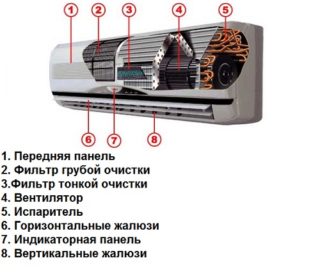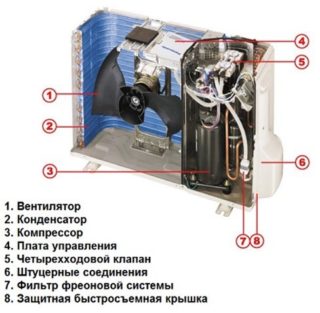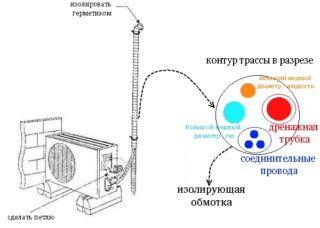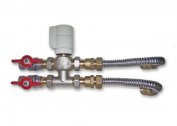Regular maintenance of the air conditioner requires disassembling its indoor and outdoor unit. This is necessary when replacing parts of the split system and its complete cleaning. It is worthwhile to understand the features of the process and the consequences of improper disassembly.
How to remove the indoor unit
 To remove the indoor unit of any type of air conditioner, you need to click off the bottom clips. Most devices have them at the bottom and are indicated by arrows or serifs. Types of clips:
To remove the indoor unit of any type of air conditioner, you need to click off the bottom clips. Most devices have them at the bottom and are indicated by arrows or serifs. Types of clips:
- The hook on the wall plate is made from above. In these cases, the clips are pushed up.
- Lower hook on the plate. In such devices, additional holes are located below. Fasteners pull down from the block.
- Clips located under the decorative cover. First, remove the cover, and then wring out the mount.
The removed internal module of the air conditioner is easier to disassemble.
Dismantling the air conditioner indoor unit
You can disassemble the indoor unit of the split system after disconnecting the device from the network. Then open the housing cover and remove the filters. The next step is to remove the housing:
- Any air conditioner has self-tapping screws on the bottom, which are easy to find under the plugs. They need to be unscrewed.
- Under the cover, behind which the filters are located, self-tapping screws or latches can also appear. After unscrewing, you can open the lower element of the housing.
- The next task is to release the latches located in the upper part of the housing. They are quite rigid, to disconnect them you need to know the features of the mount. Most often they can be unlocked by pulling the bottom of the case toward you and up.
- It remains to disconnect all the wires, if any.
Having opened the blinds, it is easy to remove the housing by pulling it towards you.
The next step is to remove the drainage tank. Some models are made monolithic, so they cannot separate the tray from the case. It is important to understand the features of its installation, so that when assembling it is correctly installed in place.
We recommend preparing containers for condensate from the tray. To disassemble the container, it is enough to unscrew one self-tapping screw, and then disconnect the clips at the bottom. It is necessary to disconnect the blind motor from the tray. After removing the container, the tail of the drainage hose is separated.
The next task is to remove the fan (shaft). This procedure is the most responsible and complex. A simple shaft removal option is applicable when it is removed to the left without affecting the control unit and engine:
- Unscrew and free the left side of the radiator from the device body.
- Unscrew the fastener on the right side of the shaft by several turns. This screw is often tightened strongly, so it is important to be careful not to damage the head of the fastener and break the blades.
- Remove the shaft from the bottom of the housing, taking care of the safety of parts. Since the fan is often installed quite tightly, it takes a lot of experience to remove it. The screw can be held with a screwdriver while pushing the shaft.
When mounting the shaft in the housing of the device, the screw should be exactly in its original position. Otherwise, the fan will touch the walls.
There is a more complicated option for removing the fan. If the shaft is pulled out on the right side, you will have to remove the electric motor and control unit.
Sequencing:
- Remove control unit from housing. This will require disconnecting all wires and sensors. Then the latches are disconnected and the screws securing the control unit are unscrewed.
- Unscrew all motor mounts. Detach cover with shaft.
- Carefully examine how the shaft is disconnected from the motor. Carefully bend the copper tubes that fit the heatsink.
Dismantling the external module
Dismantling a mobile or window air conditioner does not take much time - just remove the device from the window or remove the air duct. When disassembling a full-fledged split system, it is required to save all the refrigerant.
 The connecting tubes through which freon is transported have a different diameter. The thin channel is used to transport liquid refrigerant. The large tube is designed for pumping gaseous freon. When disassembling the air conditioner, it is necessary to “drive” the refrigerant into the outdoor unit. Then you can disable the trunk channels. For pumping the refrigerant, it is necessary to screw the pipe with liquid freon, which leaves the outdoor unit into the room, while the device is running. The device pumps gaseous matter into the outdoor unit in 1 minute. After that, immediately turn off the device.
The connecting tubes through which freon is transported have a different diameter. The thin channel is used to transport liquid refrigerant. The large tube is designed for pumping gaseous freon. When disassembling the air conditioner, it is necessary to “drive” the refrigerant into the outdoor unit. Then you can disable the trunk channels. For pumping the refrigerant, it is necessary to screw the pipe with liquid freon, which leaves the outdoor unit into the room, while the device is running. The device pumps gaseous matter into the outdoor unit in 1 minute. After that, immediately turn off the device.
Dismantling the outdoor unit of the air conditioner is performed together. So you can eliminate unnecessary risk and reduce the time of work.
After disconnecting the device from the power supply, disconnect the cables by marking the terminals.
The copper channels through which the refrigerant is transported can be straightened independently, being careful. Together with them, the electric cable is removed into the room. It is screwed to the end of the tube. Then you need to unscrew the nuts that hold the outdoor module. Remove the block together. Lastly, the brackets are removed from the wall.
The removed outdoor module requires vertical storage and transportation. To exclude possible damage, it is placed in a foam box.
Compressor removal
In some cases, it is only necessary to dismantle the outdoor unit, for example, when it is necessary to adjust the compressor. The indoor unit in this case remains in place. The main task is to remove the compressor correctly:
- dismantle the cover of the outdoor unit;
- disconnect the discharge and suction tubes;
- disconnect the electrical wires;
- unscrew the fasteners of the fan and condenser;
- remove the capacitor from the housing;
- dismantle the compressor mounts and the part itself.
By performing this sequence of actions, you can reduce the risk of damage to pipelines and gain access to other elements located in the housing.
The consequences of improper dismantling
 Incorrect dismantling can easily damage the air conditioner. Possible unpleasant consequences:
Incorrect dismantling can easily damage the air conditioner. Possible unpleasant consequences:
- Depressurization of the cooling circuit, which entails a leak of freon. During the subsequent installation of the device, you will have to pay extra for refueling the system with refrigerant.
- Mechanical damage to the outdoor unit casing, freon tubes, and other parts.
- Clogged cooling circuit with debris, moisture. When dust enters, the compressor wears out faster. Water can oxidize the surface of the copper freon track, causing the entire system to fail.
- Falling outdoor unit from a height. The installation height of the module is not important - after falling it will have to be replaced in any case.
Air conditioning is usually dismantled during a change of residence, during repair and cleaning. When disassembling simple units, you do not have to understand their device. However, full-fledged split systems require a careful approach. Since the equipment is expensive, it is better to contact professional installers who will perform the work efficiently and with a guarantee. You can disassemble the device yourself only with full confidence in understanding its device.



